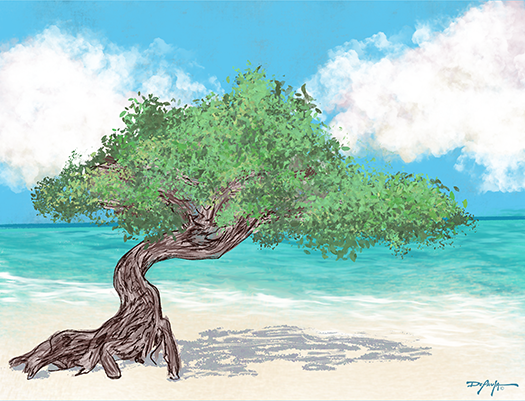
The Aruban Soul of the Fototi Tree
Share
The call of the horizon is a constant whisper for an explorer, a siren song that promises new colors, new textures, and new stories. Recently, that song led me away from the familiar greens and blues of the Florida Keys to a different kind of island paradise: Aruba. Known as "One Happy Island," I was eager to discover the source of its joy and, as always, to see what artistic inspiration its unique landscape held for me.
From the moment I stepped onto the island, I was struck by the dramatic contrast of its terrain. While the southwestern coast boasts the picture-perfect white sands and tranquil, turquoise waters you see on postcards, the northeastern coast is a wild, rugged testament to the power of the wind and waves. It’s a landscape carved by the elements, with cacti standing tall against the arid, desert-like interior and rocky shores pounded by the relentless Atlantic. This duality is the heart of Aruba's character—it's both serene and wild, gentle and fierce.
My days were spent in a state of blissful exploration. I wandered the vibrant, Dutch-colonial streets of Oranjestad, sketching the colorful facades and bustling market life. I hiked through Arikok National Park, marveling at the ancient cave paintings and the stark beauty of the cacti-studded hills. But it was on the coast, on the world-renowned Eagle Beach, that I found the icon I was searching for, the singular image that seemed to embody the spirit of the entire island.
It was the Fofoti tree.
You’ve likely seen it in photographs, even if you didn't know its name. The Fofoti trees, often mistaken for Divi-divi trees, are Aruba's unofficial mascots. What makes them so captivating is their dramatic, windswept shape. The constant, unrelenting trade winds force the trees to grow in a southwesterly direction, their trunks and branches sculpted into a graceful, sideways arc. They look like they are in a constant state of bowing to the sea, their forms a living sculpture carved by the invisible hand of the wind.
I spent an entire afternoon with one particular Fofoti tree. I watched how the light played through its twisted, gnarled bark and how its leaves rustled in the ever-present breeze. It stood as a symbol of resilience and adaptation, thriving in an environment of constant pressure, yet appearing serene and beautiful. Its silhouette against the setting sun, with the gentle Caribbean waves lapping at the shore just feet away, was one of the most peaceful and powerful scenes I have ever witnessed. I knew, with the certainty that only an artist can feel, that this was a story I needed to tell with my brushes.
Back in my studio, the memory of that tree was a vivid presence. I wanted my painting to capture not just the look of the Fofoti, but the feeling of being there—the warmth of the sand, the sound of the wind, the incredible clarity of the light. I focused on the dynamic interplay between the tree's gnarled, shadowy bark and the brilliant, sun-drenched beach and ocean. The challenge was to convey that sense of constant motion in a static image, to make the viewer feel the trade winds just by looking at the canvas.
To share this piece of Aruba's soul, I’ve had the painting reproduced as a fine art canvas print. It’s a piece I’m incredibly proud of. Each print is created on a fade-resistant, 20.5 mil thick poly-cotton blend canvas with a matte finish that captures the richness of the colors. The canvas is meticulously hand-stretched over solid wood stretcher bars, creating a gallery-quality piece that is ready to bring a touch of that Aruban magic to your space. It's a window to a place of resilience and beauty, a tribute to the enduring spirit of the Fofoti tree.
You can see the completed work here: Aruba's Fofoti Tree on the Beach Fine Art Canvas.
